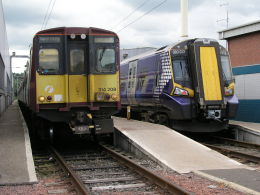Posted 11th July 2012 | 5 Comments
£12m Paisley electrification confirmed

The Paisley Canal service will be worked by Class 314s (left) but also by new Class 380s (right) in the peaks
NETWORK RAIL and ScotRail have confirmed a £12 million joint investment to electrify the line between Corkerhill and Paisley Canal by December. The work, by contractor Babcock, is starting this week.
The electrification will be the first major project to be carried out by a new ‘deep alliance’ between Network Rail and ScotRail.
The line is already electrified as far as Corkerhill for depot movements, and the new scheme will extend the wires to the terminus at Paisley Canal, allowing the service from Glasgow Central to be operated by electric units.
The cost is 'significantly' lower than original estimates, partly because ScotRail is waiving its right to disruption compensation, but also because there will be extended neutral sections under overhead structures, and therefore less rebuilding. This strategy was outlined in Network Rail's recent Alternative Solutions RUS, published in February.
The use of long neutral sections on the Paisley Canal line was also forecast by Network Rail CEO David Higgins when he gave evidence to the House of Commons Transport Committee on 19 June. At the time, he said: "If we did that to a traditional specification without heavy consultation with ScotRail, it would cost x amount of money. We are going to halve the amount of money that we spend just because we have changed the specification. We have put neutral sections under the bridges because we have come up with a performance specification that we and the operator believe we can all live with."
More savings have been made by re-assessing clearances so that diesel units can still provide the service if necessary, and also to allow freight trains to use the line in future.
ScotRail managing director Steve Montgomery described the project as 'ground breaking'. He said that it was "a leaner, more efficient way of working and sets the standard for future rail projects in Scotland".
Network Rail route commercial manager Susan Anderson added: "This is the first tangible benefit for rail customers to be delivered through this alliance with ScotRail. We are delighted to be able to achieve this much more quickly than under traditional arrangements."
The Paisley Canal line is set to be worked in the peaks by Scotland's newest electric trains, the Siemens-built Class 380s. At other times older Class 314 electric units will probably be used.
Reader Comments:
Views expressed in submitted comments are that of the author, and not necessarily shared by Railnews.

Brian George, Nottingham
We are far too slow in reconnecting communities to the Network. We miss opportunities.
In the Midlands you could relay the Matlock to Buxton line through Bakewell and have a complete ready to hand relief route from Derby through to Manchester. Relaying all of 8 miles of which one million pounds has already been spent by the Dft to refurbish the twin tunnels on the route and track bed.
In Devon by relaying short distance of track between Okehampton and Bere Alston you create a new through route between Exeter and Plymouth.
Sidmouth, Budleigh Salterton, Bideford, Bude, Launceston, Wadebridge and Padstow all need to be reconnected. Yet the Government turns a blind eye to it.
In Scotland the line needs to go forward from Tweedbank, on the new extension to Hawick, a few miles on. Hawick townsfolk were vociferous in objecting to railway closing in the first place, siting their need to get to Edinburgh.
In the South the lines around Uckfield need to be revisited with a view to reopening several lines closed in that area, and over towards Guildford.
All these improvements would reconnect communities and get traffic off roads in the area. Saving money and the environment in the long term and proving a good legacy for the children of the future. The money coming from existing Network Rail and Dft budgets. Not new money from the Treasury.
Brian.
Stuart Kelly, Lanark
Lets not get carried away here, there is nothing new about the methods being used for the electrification of this scheme. Neutral sections have been used elswhere on the network where clearances are tight, and were done so as early as the 90's (Newton-On-Ayr).
This infill scheme has been spoken about for a number of years also.
neave, london
If under bridge neutral secions are now OK. How about 25kv on the west london line south from mitre bridge junction so the 3rd rail change over cvan be at the new Shepherds Bush station a mile further south.
Then a special 1 min mitre bridge junction stop can be avoided for changeover for the Southern 377 units or the risky 378 unit 20 mph panto up/down move can be ended.
Leslie burge, leicester
Why can't there be more alliances between Network Rail and companies in England to get electrification moving forward faster? Surely we will all benefit as running costs would come down. Everything in England seems to be done at snail's pace unless it is around London.
Melvyn Windebank, Canvey Island, Essex
Yet again Scotland pushes ahead while here in England we cant even get Gospel Oak to Barking electrified, Perhaps its time to take the DFT out of these decisions!!
Also, if seep alliance in Scotland can deliver electrification then surely allience between Network Rail and South West trains should do the same with diesels that still use Waterloo Station?